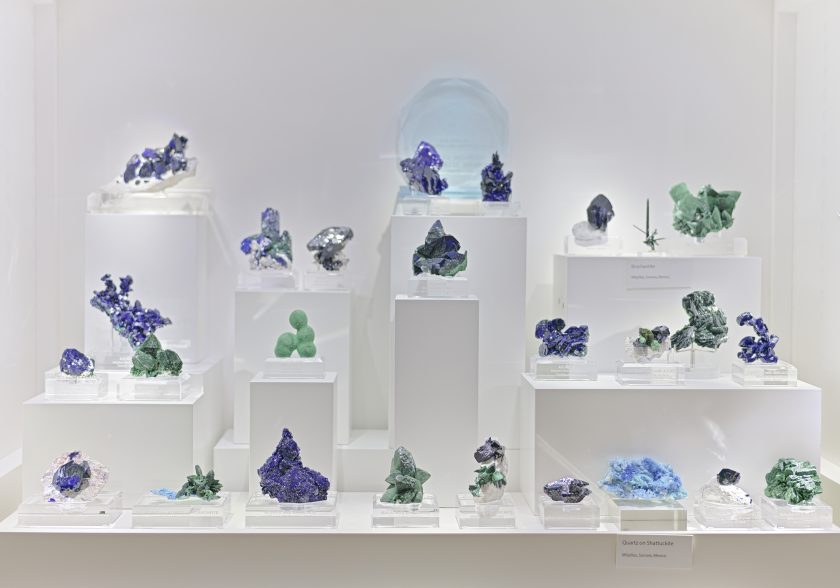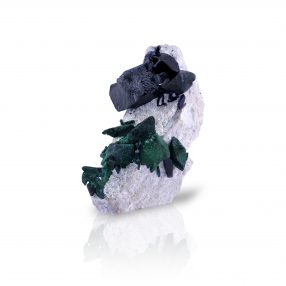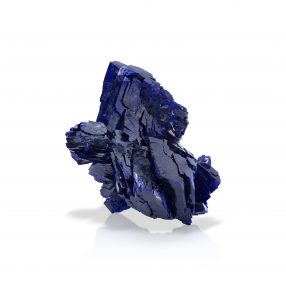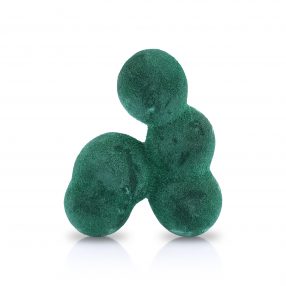World-Class Mexican Minerals Join the Jackson School of Geosciences Collection
March 10, 2025

Sparkling with rich inky blues and vibrant greens, you don’t need to be a geologist to appreciate the 40 Mexican ore minerals that recently joined the gem and mineral collection at The University of Texas at Austin’s Jackson School of Geosciences, thanks to a generous donation from Eric Long and spouse Tracy Walsh.
The beauty of the minerals, which are on public display in the school’s Hamman Gem and Mineral Gallery, speaks for itself.
And in the case of one blue azurite specimen, it’s backed up with a trophy. The mineral is the 2022 Miguel Romero Memorial Award winner, an honor bestowed to the best Mexican mineral at the world-renowned Tucson Gem & Mineral Show. (The trophy is displayed alongside the mineral in the gallery case.)

But for the geologically inclined, the Long Collection offers unique insight into the geology of a copper mine, with the majority of the collection hailing from the Milpillas Mine of Sonora, Mexico. The mine produced some of the best specimens of azurite and malachite in the world before operations were indefinitely suspended in 2020 after 13 years of operation. Many of these specimens can now be seen at the Jackson School.
“Azurite is a geology student’s mineral. We teach it in every mineral class,” said Kenneth Befus, associate professor of practice at the Department of Earth and Planetary Sciences and the curator of the school’s gem and mineral collections. “It’s an amazing blue color, and since it’s a copper mineral, it matters to the global economy. And we now have 15 world-class azurites.”
The Long Collection features minerals from each of the four main working levels of the mine. Together they document the geochemical changes that happened during ore formation. One specimen in the collection even serves as record of a chemical transition — changing from blue azurite to green malachite in the scope of a single mineral.
All the minerals in the collection are ore minerals, meaning they contain valuable concentrations of metals, (in this case copper, mostly copper) that are mined for many industrial applications. But most of the value of the minerals in the Long Collection is related to the rarity of having minerals representative of the entire ore body and the aesthetic value of the collection, rather than the metals they contain.
“These minerals are not trimmed, they’re not polished. This is what nature does on its own, forming these crystals, these beautiful things,” said Long.
Long and Walsh have been collecting minerals for about 15 years, frequenting rock shows to find new specimens. (And explaining to friends that they were indeed travelling to see literal rocks, not rock bands.)
But Long’s interest in geosciences reaches much further back. His family moved around a lot while he was growing up and each new city offered a new museum with a rock collection to explore. In college, he studied petroleum engineering and geology, going on to become the president and CEO of the oil and gas services company USA Compression. He retired from that role in October 2024.

Long and Walsh have donated minerals to Arizona State and the Colorado School of Mines. And there was plenty of interest in their collection of Mexican ore minerals from both university and national collections, Long said. But they decided on The University of Texas at Austin as the home for this special collection for a few reasons. They wanted to pay tribute to the historical connection between Texas and Mexico, and beyond that, they wanted to spark conversations about mining at a university known for its energy research.
“It’s such a forward-looking venture to seed the collection in its early stages,” Long said. “UT has the expertise and interest here, and these minerals can help with their mission of education.”
Jackson School Dean Claudia Mora said that the Long Collection complements the school’s growing research into critical minerals and mining, and is a great entry point for all of campus to learn more about the geosciences.

“The beauty of this gift isn’t just in the dazzling brilliance of the mineral specimens, but in its representation of a large ore system,” she said. “This is an amazing teaching collection for any Earth science program. I am grateful to Eric and Tracy for their generosity and their investment in the future of the Jackson School.”
So, what’s the best mineral out of the whole collection? For Long, it’s all a matter of personal preference.
The award-winning azurite might check all the right boxes for the mineral connoisseur. But there’s also the stacked spheres of malachite that look like a green globular rabbit. It’s not going to win any trophies at the Tucson Gem & Mineral Show. But if it sparks an interest in geosciences, that’s a priceless specimen in his book.
“It’s the least valuable … but it can start that connection right there,” he said.
For more information, contact: Anton Caputo, Jackson School of Geosciences, 210-602-2085; Monica Kortsha, Jackson School of Geosciences, 512-471-2241; Constantino Panagopulos, University of Texas Institute for Geophysics.
